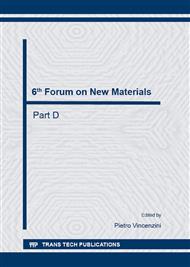[1]
K. J. Anusavice, Phillips Materiais Dentários, 11ª edição, Elsevier Editora Ltda, Rio de Janeiro, (2005).
Google Scholar
[2]
M. Guazzato, M. Albakry, S. P. Ringer, M. V. Swain, Strength, fracture toughness and microstructure of a selection of all-ceramic materials. Part II. Zirconia-based dental ceramics, Dental Materials, 20 (5) (2004) 449-456.
DOI: 10.1016/j.dental.2003.05.002
Google Scholar
[3]
D. -J. Kim, M. -H. Lee, D. Y. Lee, J. -S. Han, Mechanical Properties, Phase Stability, and Biocompatibility of (Y, Nb)-TZP/Al2O3 Composite Abutments for Dental Implant, J. Biomed Mater Res, 2000 53 (4) 438-443.
DOI: 10.1002/1097-4636(2000)53:4<438::aid-jbm19>3.0.co;2-3
Google Scholar
[4]
X. -J. Sheng, H. Xu, Z. -H. Jin, Y-L. Wang, Preparation of glass-infiltrated 3Y-TZP/Al2O3/glass composites, Materials Letters, 58 (11) (2004) 1750-1753.
DOI: 10.1016/j.matlet.2003.10.062
Google Scholar
[5]
W.D. Wolf, K.J. Vaidya, L.F. Francis, J. Am. Ceram. Soc. 79 (7) (1996) 1769.
Google Scholar
[6]
S. -J. Lee, W.M. Kriven, J. Am. Ceram. Soc. 80 (8) (1997) 2141.
Google Scholar
[7]
J. -M. Tang, Y. -L. Zhang, S. -X. Zhang, J. Am. Ceram. Soc. 82 (6) (1999) 1592.
Google Scholar
[8]
W. D. Wolf, L.F. Francis, C. -P. Lin, J. Am. Ceram. Soc. 76 (10) (1993) 2691.
Google Scholar
[9]
K. Niihara, R. Moreno, D.P.H. Hasselman, Evaluation of KIC of brittle solids by the indentation method with low crack-to-indent ratios. J Mat. Sci. Letters (1) (1982), 13-16.
DOI: 10.1007/bf00724706
Google Scholar
[10]
J. L. Shi, Z. L. Lu, J. K. Guo, Model analysis of boundary residual stress and its effect on toughness in thin boundary layered yttria-stabilized tetragonal zirconia polycrystalline ceramics, J Mat Res, 15 (3) (2000) 727-732.
DOI: 10.1557/jmr.2000.0105
Google Scholar
[11]
J. L. Shi, L. Li, J .K. Guo, Boundary stress and its effect on toughness in thin boundary layered and particulate composites: model analysis and experimental test on T-TZP based ceramic composites, J Eur Ceram Soc, 18 (1998) 2035-(2043).
DOI: 10.1016/s0955-2219(98)00157-5
Google Scholar
[12]
A. A. C. Lourenço, Produção, processamento e ceracterização de espinélio para aplicação odontológica, MsC Dissertation, UFRJ-Brazil, 79p. (2008).
Google Scholar
[13]
J.L. Shi, Z.L. Lu, and J.K. , Guo, Model analysis of boundary residual stress and its effect on toughness in thin boundary layered yttria-stabilized tetragonal zirconia polycrystalline ceramics; J Mat Res, 15 (3) (2000) 727-732.
DOI: 10.1557/jmr.2000.0105
Google Scholar
[14]
M. Taya, S. Hayashi, A.S. Kobayashi, H.S. Yoon, Toughening of a particulate-reinforced ceramic-matrix composite by thermal residual stress., J Am Ceram Soc, 73 (5) (1990) 1382-1391.
DOI: 10.1111/j.1151-2916.1990.tb05209.x
Google Scholar
[15]
Y. -H Sun, Y-F Zhanga, J-K. Guo, Microstructure and bending strength of 3Y-TZP ceramics by liquid-phase sintering with CAS addition, Ceramics International 29 (2003) 229-232.
DOI: 10.1016/s0272-8842(02)00097-4
Google Scholar
[16]
X.W. Huang, S.W. Wang, X.X. Huang, Microstructure and mechanical properties of ZTA fabricated by liquid phase sintering , Ceramics International 29 (2003) 765-769.
DOI: 10.1016/s0272-8842(02)00228-6
Google Scholar
[17]
C. Santos, R.C. Souza, A.F. Habibe, L.D. Maeda, M.J.R. Barboza, C.N. Elias, Mechanical properties of Y-TPZ ceramics obtained by liquid phase sintering using bioglass as additive, Mat Sci Eng A, 485, (2008) 422-427.
DOI: 10.1016/j.msea.2007.06.009
Google Scholar


